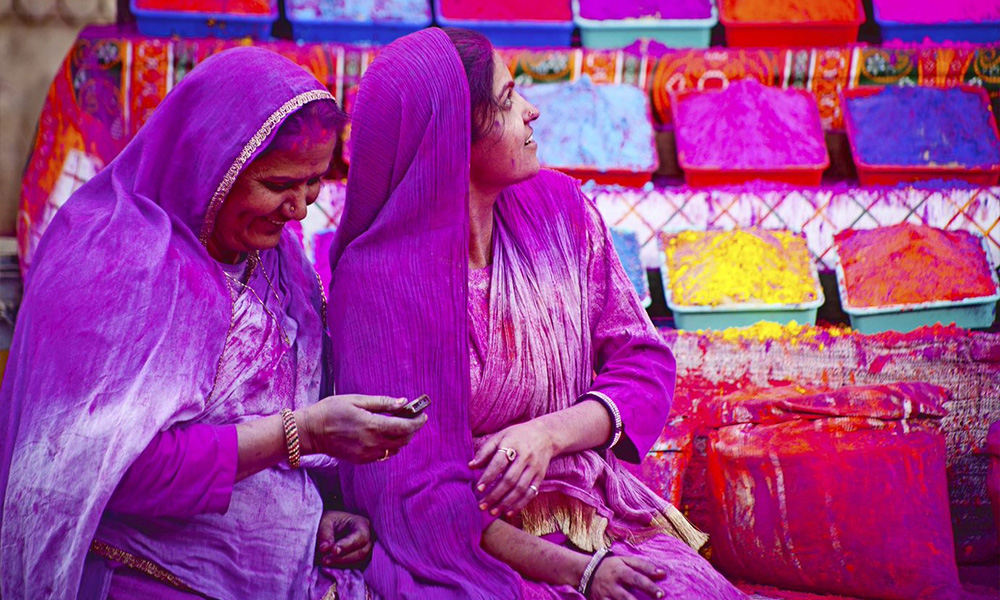The Holi festival marks the win of good over evil, It is known as also known as the "Festival of Colors" because Lord Krishna (a reincarnation of god Vishnu), who liked to play tricks with the village girls by wetting them in water and colors. It comes in the month of March at the end of the winter season. The festival reminds the end of winter and the wealth of the upcoming harvest and spring season.
Why is Holi celebrated?
There is a mythology story behind the Holi Festival. Prahlada (son of demon Hiranyakashipu) was a great devotee of Lord Vishnu but his father didn’t like this doing of his son. Despite warned by his father several times, Prahlada continued to worship Vishnu. Holika's sister of Hirranyakashipu was blessed in that she could not be hurt by fire. One day Hiranyakashipu decided to put his son on the lap of his sister Holika as she sits on a pyre. Prahlada prayed to Lord Vishnu to keep him safe. Holika then burned on the pyre to death and Prahlada is left unburned. This is known as Holika Dahan.
Celebration of Colors: The main highlight of Holi is the exuberant play of colors. People of all ages come together to smear each other with dry and wet colored powders, known as "gulal" and colored water, using water guns and water-filled balloons. The streets and open spaces become a riot of colors as people drench each other in joy and merriment.
Bonfires on Holika Dahan: The festivities typically begin on the evening before the main Holi day with a ritual called "Holika Dahan." Bonfires are lit to commemorate the victory of good (represented by Prahlad) over evil (represented by his demoness aunt Holika) from Hindu mythology.
Cultural and Religious Significance: Holi has several religious and cultural significances. In addition to celebrating the victory of good over evil, Holi is associated with various Hindu legends, including the love story of Radha and Krishna. The festival also signifies the end of winter and the beginning of the spring season, bringing new life and hope.
Community and Togetherness: Holi is a festival that breaks barriers of age, gender, and social status. It fosters a sense of unity and togetherness, as people forget their differences and come together to celebrate joyfully. It is a time for merrymaking, dancing, singing, and feasting with friends, family, and neighbors.
Traditional Delicacies: Special Holi delicacies, such as "gujiya" (sweet dumplings filled with khoya and nuts), "puran poli" (sweet flatbread with lentil filling), and "thandai" (a milk-based drink with spices and nuts), are prepared and shared during the festival.
Holi Events and Festivities: In addition to the informal celebrations on the streets and in homes, many places organize larger public events, including "Holi parties" and cultural programs with music, dance performances, and food stalls.
It's important to note that while Holi is a fun and colorful festival, it is essential to celebrate it responsibly and with respect for others. Some people may not want to participate in the color play, so always seek consent before applying colors to anyone. Additionally, use safe and eco-friendly colors to protect the environment and your health.
Holi is a festival that brings out the spirit of joy, love, and togetherness in people, making it an unforgettable experience for both locals and visitors alike. If you get the opportunity to celebrate Holi in India, be prepared to immerse yourself in a kaleidoscope of colors and the infectious enthusiasm of the festival.
On the Holi festival day, people spend their morning activity by throwing coloured powder and water on each other with the chant “Bura Na Mano Holi Hai” so people don’t get angry with each other. These celebrations go on till afternoon. There are no rituals that need to be performed.
Lathmar Holi celebration – It is celebrated days before the Holi Festival near Mathura in Uttar Pradesh, The women of Barsana and Nandgaon villages beat up men with Lath (stick). Generally, Lathmar Holi takes place approx a week ago from Holi in Nandgaon.
Holi Celebration in Mathura and Vrindavan - Celebrations start a week before the actual date of the Holi Festival. Week-long Holi celebrations at Banke Bihari Temple (temple of lord Krishna) in Vrindavan commence around 4 p.m. on Aanola Ekadashi with the throwing of flowers (Phoolon Wali Holi), The festivities at Vrindavan goes till the day before Holi with the throwing of colours in the morning. Colourful Holi procession takes place at about 3 p.m. in Mathura. Plus, the throwing of colours the next day.
Top Places to Celebrate Holi
You will find celebrations taking place almost all over India. In Northern India, the best place to celebrate Holi in Delhi, Jaipur, and Agra. In West Bengal and Odisha, this festival is celebrated as Dol Jatra.
Barsana, Uttar Pradesh – Lathmar Holi
Mathura and Vrindavan – Traditional Holi
Shantiniketan, West Bengal – Cultural Holi
Anandpur Sahib, Punjab – Warrior Holi or Hola Mohalla
Udaipur, Rajasthan – Royal Holi
Jaipur, Rajasthan – Holi, and Elephants
Mumbai and other parts of India – Community Holi
